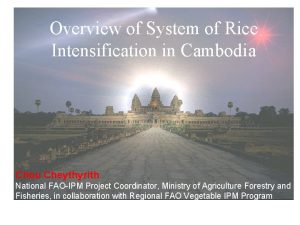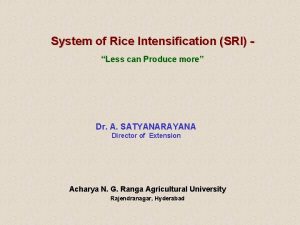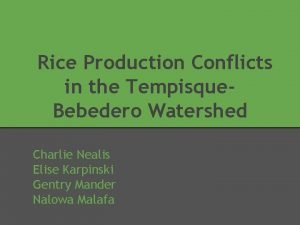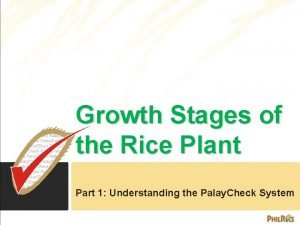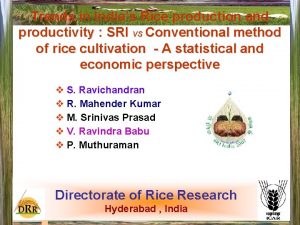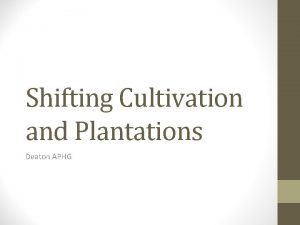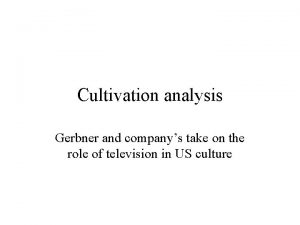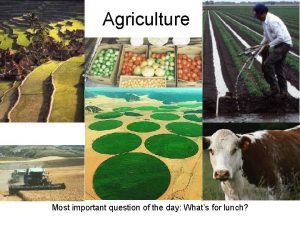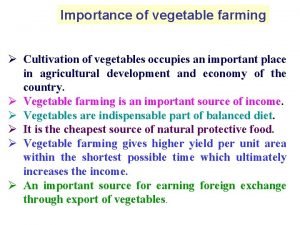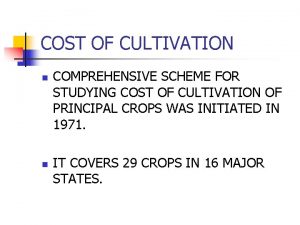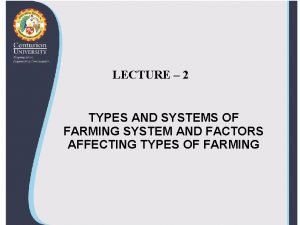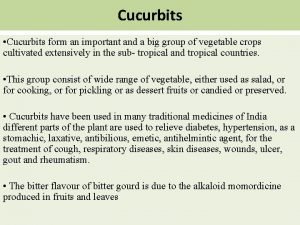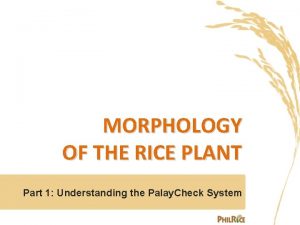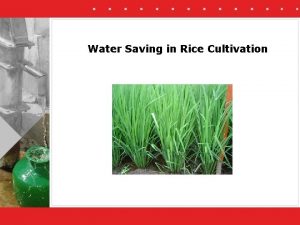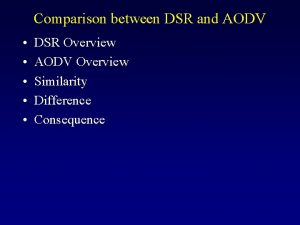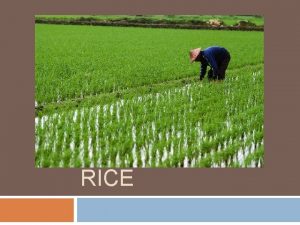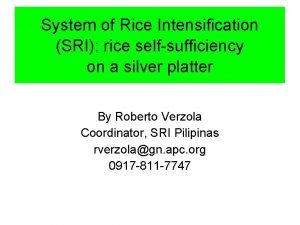SCIENTIFIC METHOD OF RICE CULTIVATION DSR SRI and



























































- Slides: 59

SCIENTIFIC METHOD OF RICE CULTIVATION (DSR, SRI and Normal transplanting) Dr. SHIVNATH DAS Jr. Scientist, Agronomy BRC, Islampur (ARI, Patna)

Major concern q Increase in human population. (1. 2 Billion by 2020) q Decline in per capita availability of land 0. 11 ha by 2020 from 0. 33 ha in 1951 q q Per capita water availability assessed by FAO • > 5300 m 3 in 1951 • 1905 m 3 in 1999 • < 1500 m 3 by 2025 • Rice consumes about 4000 -5000 ltr. of water to produce 1 kg of grain Food demand of 326 mt by 2020 (involving 130, 110, 58 and 28 rice, wheat, coarse grain and pulses, respectively).

Challenges for enhancing rice production v Declining resource base Land Water Labour v Deteriorating soil health v Increasing environmental concerns v Increasing cost of cultivation Among these water is becoming a critical factor

Direct seeding of rice (DSR) Direct seeding of rice refers to the process of establishing a rice crop from seeds sown in the field rather than by transplanting seedlings from the nursery. (water seeding) or dry seeding into a prepared seedbed (dry seeding) It involves sowing pre-germinated seeds into a puddled soil surface (wet seeding), standing water (water seeding) or dry seeding into a prepared seedbed (dry seeding). Direct seeding avoids three basic operations, namely, puddling , transplanting and maintaining standing water. Thus, there are three principal methods of direct seeding of rice (DSR): (i) dry seeding (sowing dry seeds into dry soil), (ii) wet seeding (sowing pre-germinated seeds on wet puddled soils) and (iii) water seeding (seeds sown into standing water)

Contd. . . . Ø DSR with suitable conservation practices has potential to produce slightly lower or comparable yields as that of TPR if properly managed and appears to be a viable alternative to overcome the problem of labour and water shortage and reduce GHG emission Ø If not managed efficiently, weeds may cause partial to complete failure of DSR crops. ØFrom sowing to emergence, the soil should be kept moist but not saturated to avoid seed rotting

Seed priming in DSR Seed priming tools have the potential to improve emergence and stand establishment under a wide range of field conditions, These techniques can also enhance rice performance in DSR culture. Methods of seed priming (Farooq et al. , 2006) Slow hydration and Mixing of sand+chemical then placed the seed in b/n moist sand dehydration for 16 hrs till 30% gain of excess moisture. After that dry 24 hrs in shed Seed fortification Chemical(100 ppm znso 4 +1 kg seed +350 ml water Seed infusion Organic solvent (PEG, acetone, ethonol) +chemical (micro nutrient, growth regulator, herbicide) + seed. Then left for 24 hrs Solid matric priming Seed + water+ solid carrier (VC, FYM, peat moss, sand) Osmo priming Osmotic sol( PEG 600, manitol, salt like Nacl, Mgso 4, KNO 3) + seed


Filling of pre-germinated paddy seed into the drums Pulling the drum-seeder in the puddled field without any standing water Seed dropped from the drumseeder is seen in rows of 20 cm width

Direct-seeded plot 20 days after sowing Direct-seeded plot 40 days after sowing Direct-seeded paddy ready to harvest

What is SRI. . . ? It is a set of modified practices for growing rice which was developed in Madagascar in 1983 by Father Henri Laulanie. Features Planting young seedlings 8 – 12 days old Planting single seedling/hill Along with soil Wider Spacing 25 cm x 25 cm Organic manuring Compost , Gm , Straw No standing water till PI stage Alternate wetting and drying Aerated Soil Weeding by Cono-weeder

What Are the Basic Ideas for SRI? 1. 2. 3. 4. 5. 6. TP young seedlings to preserve growth potential (although DIRECT SEEDING is becoming an option) Avoid trauma to the roots -- transplant quickly and shallow, not inverting root tips which halts growth Give plants wider spacing -– one plant per hill and in square pattern to achieve “edge effect” everywhere Keep paddy soil moist but unflooded –- soil should be mostly aerobic, never continuously saturated Actively aerate the soil as much as possible Enhance soil organic matter as much as possible First 3 practices stimulate plant growth, while the latter 3 practices enhance the growth and health of plants’ ROOTS and of soil BIOTA

Benefits of SRI *It reduces 65 -70 per cent seed; * Saving of water about 35 -45 per cent; *More number of tillers/productive tillers; * More number of spiklets per panicle; *Uniform maturity; *Head rice recovery is more; *Early maturity (5 -20 days); *Plants are healthy and resistant to major pests and diseases; *Yield advantage(1. 5 to 2. 00 time) over the conventional method; *No competition between rice plant and weeds.

Wet Bed Nursery

WET NURSERY: Seeding 20 gm / m 2

12 days old seedlings from SRI and traditional (right side) nursery

Seedlings uprooting



Photo: Transplanting

Drainage channel

Criss cross Weeder Use

16 day old seedling: at 30 days after transplanting


Rice ecology and suitable varieties

mijh tehu gsrq 'kh? kz idus okyh iz. Hksn)) m. Uur iz. Hksn r. S; kj gksus dh vofèk ¼fnuksa esa½ vk. Slr mit ¼f. Do 0@gs 0½ rqj. Urk 75&80 20 -25 iz. Hkkr 90&95 30 -35 lkdsr 4 110&115 30 -35 fj. Nkkfj; k 110&115 30 -35 ljkst 110&115 30 -35 èkuy{eh 110&115 25 -35

eè; e tehu gsrq ¼eè; e vofèk esa idus okyh½ m. Uur iz. Hksn r. S; kj gksus dh vofèk ¼fnuksa esa½ vk. Slr mit ¼f. Do 0@gs 0½ lhrk 130&135 40&45 dud 135&140 45&50 vkb. Z- vkj- 36 120&125 40&45 jkts. Unz 'osrk 135&140 40&45 larks"k 135&140 40&45 lg. Hkkxh 130&135 40&45

uhph tehu gsrq ¼nsj ls idus ck. Su d. Les a okyh ½ m. Uur iz. Hksn r. S; kj gksus dh vofèk ¼fnuksa esa½ vk. Slr mit ¼f. Do 0@gs 0½ jkts. Unz eglwjh 1 145&150 50&55 , e-Vh-; w- 7029 ¼Lo. k. Zk½ 150&155 50&55 ch-ih-Vh- 5204 ¼l. EHkk eglwjh½ 145&150 45&50 Lo. kk. Z lc&1 140&145 40&50 jkt. Jh 140&145 40&45 l. R; e 140&145 40&45

pk. Sj , oa Xkgjs ikuh gsrq ¼ 1 -0 eh- rd½ m. Uur iz. Hksn r. S; kj gksus dh vofèk ¼fnuksa esa½ vk. Slr mit ¼f. Do 0@gs 0½ Lkqèkk 150&160 `25&30 tkudh 150&160 `25&30 o. Snsgh 150&160 30&35

Lakdj èkku ¼eè; e vofèk es a idu s okyh½ m. Uur iz. Hksn r. S; kj gksus dh vofèk ¼fnuksa esa½ vk. Slr mit ¼f. Do 0@gs 0½ Ikh-, p-ch- 71 130&135 75&80 ds 0 vkj 0, p 0 2 130&135 70&75 ih 0, 0 644 130&135 80&90 iwlk vkj 0, p 0 10¼laxq fa èkr½ 115&120 60&65 i. Ur ladj èkku 1 110&115 55&60

Lqkxafèkr èkku ¼eè; e , oa nh? k. Z vofèk es a idus okyh½ m. Uur iz. Hksn r. S; kj gksus dh vofèk ¼fnuksa esa½ vk. Slr mit ¼f. Do 0@gs 0½ ch-vkj- 9 150&155 25&30 dkfeuh 150&155 25&30 jkts. Unz lqokfluh 25&130 40&45 jkts. Unz d. Lrqjh 25&130 40&45 jkts. Unz Hkxorh 110&115 40&45 Lqkxaèkk 150&155 25&30

Recent released varieties of rice in Bihar

SABOUR SURBHIT: (Released in 2012) Aromatic fine grain rice with yield potential of 40– 45 quintal per hectare and can perform well under limited irrigated condition also.

SABOUR ARDHAJAL: (Released in 2013) i. Long slender grain aerobic rice variety ii. Yield potential 50 – 55 quintal. ha-1 iii. Suitable for upland medium land iv. Saves about 50% water requirement

SABOUR SHREE: (Released in 2014) i. Medium slender grain variety ii. Yield potential 45 – 50 quintal ha-1 iii. Suitable for medium irrigated situation

SABOUR DEEP: (Released in 2014) Early maturing aromatic fine grain rice with yield potential of 40 – 45 quintal per hectare & very much suitable for contingent plan under late arrival of monsoon.

Fertilizer management in Rice

Emerging Multi-Nutrient Deficiencies in Soils Year N ? Mo Mo B B Mn Mn Mn S S S K K K Zn Zn Zn P P P Fe Fe N N N N 1950 1960 1970 1980 1990 2000 2010 2025

Fertilizer application cht LFkyh esa , d lk. S ox. Zeh. Vj {ks=Qy dh cht@LFkyh esa D; kfj; k¡ esa fu. Eu fyf[kr ek=k esa [kkn nsa % ¼d½ 1 fdyks us=tu] 1 fdyks Qk. LQksjl] 1 fdyks iks. Vk'k ¼[k½ cht fxjkus ds 15&20 fnuks a ckn 1 fdyks u=s tu ls fcp. M+ks a dh Vki. W Msªflax djs a A [kkn dh ek=k ¼d½ mijh tehu es a t. Yn idus okyh iz. Hksn % 80% 40% 20 fd-xzk- , u- ih- ds-@gs¼[k½ m. Uur , oa vfèkd mit'khy fd. Lesa %100% 40% 20 fd-xzk- , u- ih- ds-@gs-½ ¼x½ laqxafèkr fd. Lesa % 1 - ck. Suh fd. Les a 80% 40% 20 fd-xzk- , u- ih- ds-@g-s 2 - y. Ech fd. Lesa 40% 30% 20 fd-xzk- , u- ih- ds-@gs¼? k½ ladj fd. Lesa %120% 60% 40 fd-xzk- , u- ih- ds-@gsd. Eiks. LV [kkn dk iz; ksx 10&15 Vu@gs- dh nj ls jksikb. Z ds 20&25 fnu igys djsa. A ftad l. YQs. V 25 fdyks izfr gs 0 dh nj ls eq[; [ksr dh vafre tksrkb. Z ds le; , oa dnok ds iwo. Z [ksr esa feyk; s. A

Techniques for increasing productivity Name of technology Details of Technology Diversification in existing Farmers with adequate resources have ample scope rice- wheat cropping system for crop diversification by adapting rice-garlicmaize and rice-potato-onion +maize relay cropping as alternatives, replacing wheat out of the traditional rice-wheat cropping system. Delayed transplanting Increasing fertilizer dose by 25% over the recommended one was found to be the best approach to bridge the yield gap of rice due to its delayed transplanting Reducing P- requirement by taking advantage of its Application of phosphorus in rice can be skipped residual effect without any appreciable reduction in grain yield of rice if optimum quantity of phosphorus (60 kg /ha) is applied to wheat crop.

Techniques for increasing productivity Name of technology Details of Technology Integrated nutrient Application of moderate doses of FYM (40 to 80 management in rice-wheat q/ha), wheat straw (30 to 60 q/ha) and green system manuring with Sesbania (38 to 76 q/ha) in rice can reduce the recommended dose of inorganic fertilizers by 25% in wheat to maintain productivity, soil health and sustainability of rice-wheat cropping system in long run. FYM was observed to be a better source of organic manure than wheat straw and green manuring Green manuring Sesbania aculeata with Green manuring with Sesbania aculeata during summer season gave additional grain yield of 4. 50 q/ha as compared to rice yield in rice –wheat system in the fallowing season

Weed Management in Rice

weeds are major constraint in crop production • Reduce productivity • Deplete nutrients and soil moisture • Harbour insects, diseases and nematodes • Reduce quality of produce • Increase production and processing cost Other pests 12% Weeds 37% Diseases 22% Insects 29% Fig- yield losses due to various pest Weeds alone contribute about 37% yield loss which accounts for nearly Rs. 2799 crores per annum Source : Yaduraju 2006 and Sahoo and Saraswat 1988

Weed flora in kharif cereals Weed groups Grassy Weed flora Common name Family Echinochloa colona Sanmi Gramineae Echinochloa crus-galli Sanwa Gramineae Dactyloctenium Crow feet grass Gramineae Cynodon dactylon Bermuda grass Gramineae Ageratum conyzoides Goat weed Compositeae Amaranthus spinosus Spiny amaranthus Amaranthaceae Celosia agrentea Cocks comb Amaranthaceae Eclipta alba Bhringraj Compositae Trianthema Horse purslane Aizoaceae Commelina beghalensis Day flower Commelinaceae Phyllantus niruri Hajardana Euphorbiaceae Striga Scophualiaceae aegypticum Broadleaved portulacastrum Parasitic weed Striga lutea

Common kharif grassy weeds & sedges

Common kharif BLWs

Herbicides use pattern by various crops in India Other crops Soybean 6% Plantation 4% crop 10% Rice 20% Wheat 60% Source : Yaduraju 2006 and Das etal (2012) Herbicide application is more common in wheat crop followed by rice plantation crop soybean and other crops

INTEGRATED WEED MANAGEMENT IN RICE Nursery Apply any one of the Pre-emergence herbicides viz. , Butachlor 2 l/ha, Thiobencarb 2 l/ha, Pendimethalin 2. 5 l/ha, Anilofos 1. 25 l/ha on 8 th day after sowing to control weeds in the lowland nursery. Keep a thin film of water and allow it to disappear. Avoid drainage of water. This will control germinating weeds Next Previous End

Rice (Direct seeded) Herbicides Rate of application (g/ha) Time of application Butachlor 1000 -2000 Pre-emergence Anilophos 450 Pre-emergence 2, 4 -D 500 Post-emergence Fenoxaprop-p-ethyl 100 -150 Post-emergence Pretilachlor + safner 750 + 750 Pre-emergence

Rice (Transplanted) Herbicides Rate of application (g/ha) Time of application Butachlor 1000 -2000 6 -7 DAT Anilophos 450 6 -7 DAT 2, 4 -D 500 25 -30 DAT 100 -150 20 -25 DAT 1000 20 -25 DAT Bispyribac sodium 20 20 -25 DAT Pretilachlor 750 5 -6 DAT Cyhalofop 75 Post-emergence Bispyribac sodium 20 Post-emergence Penoxsulam 20 Post-emergence Pyrazosulfuron 20 Post-emergence Metsulfuron+Chlorimuron 4 Post-emergence Fenoxaprop-p-ethyl Bensulfuron (Almix)

Critical periods of crop-weed competition in Rice Crop Critical period (DAS/DAT) Yield reduction (%) Rice (Direct seeded) 15 -45 15 -90 Rice (Transplanted) 30 -45 15 -40

Herbicide mixture for weed control Ø herbicide mixtures are chemicals containing two or more herbicides for effective and economical weed control Ø on principle, Mechanical or chemical mixing of two or more herbicides having different mode of action and varying level of activity and selectivity forms herbicide mixture” (Das T. K. , 2011)

Need of herbicide mixture Herbicide mixture is believed to be an important tool towards : Ø management of herbicide resistance in Ø Prevent of weed flora shift Ø Control of broad spectrum weeds

Herbicide mixtures for rice ØAnilofos 0. 4 kg + 2, 4 –DEE 0. 50 kg/ha ØButachlor 1. 0 kg + Propanil 2. 0 kg/ha ØButachlor 1. 0 kg + 2, 4 -DEE 0. 5 kg/ha ØBenthiocarb 1. 0 kg + Chlorimuron 4 g/ha ØAnilofos 300 g + Metsulfuron-methyl 4 g/ha

Post emergence application of Penox sulam + cyhalofop- Butyl on growth & yield of direct seeded rice Herbicide Grain Yield(q/ha) WCE(%) Penox sulam (22. 5 g/ha) 39. 30 66. 70 cyhalofop- Butyl (80 g/ha) 15. 70 36. 10 Penox sulam + cyhalofop- Butyl (150 g/ha) 48. 50 (23. 4% & 209% higher) 72. 80 (9% & 101% more) Source Singh et al (2014) Extended summary of Biennial conference on “Emerging challenges in weed management” Februry, 15 - 17, 2014. DWSR, Jabalpur, MP, India pp-216

Effect of weed management on productivity transplanted rice Herbicide Grain Yield(q/ha) WCE(%) Pendimethalin (750 g/ha ) 63. 70 28. 89 Bispyribac Na ( 50 g/ha ) 66. 0 44. 63 Pendimethalin + Bispyribac Na (750 + 25 g/ha ) at 30 DAT 68. 70 (8% & 4% higher) 46. 54 (61% & 4. 3% more) Source Singh et al (2014) Extended summary of Biennial conference on “Emerging challenges in weed management” Februry, 15 - 17, 2014. DWSR, Jabalpur, MP, India pp-131

Differences between conventional, SRI and directseeding methods (per acre) by Reddy etal, 2006 Particulars Traditional SRI method Direct seeding Seed rate (per acre) 30 - 40 kg 2 kg 15 kg Days to transplant (per acre) 30 - 40 days nursery 8 - 12 days nursery 0 days Cost of nursery (Rs/ acre) 1, 200 0 Labour required for transplanting /seeding operation (per acre) 20 15 2 Spacing Zigzag method or 20 x 15 cm 25 x 25 cm 20 x 15 cm

Contd. . Particulars Traditional SRI method Direct seeding Water management tanding water from the day of transplantation to 10 days before harvesting No standing water after transplantation stage, alternate wetting and drying only. The field is kept wet until panicle initiation stage, and from then on, 2 -3 cm standing water till 10 days before harvesting. No standing water after seeding. The field is kept wet until panicle initiation stage and from then on 2 -3 cm standing water until 10 days before harvesting. Weed management Manual weeding twice (or) some apply of weedicides 1 st time and manual weeding 2 nd time. Incorporation of weeds into the soil using conoweeder in both directions (N-S and E-W) One manual weeding with 3 -4 labourers is sufficient. Weedicide is a must once or twice. Butachlor just 1 -2 days after seeding, and if necessary 2. 4 -D. Sodium salt application at 30 35 days after seeding.

Contd. . Particulars Traditional SRI method Direct seeding Yield recovered 2, 625 kg/acre 3, 525 kg/acre 3, 375 kg/acre Total cost of cultivation Rs. 9700/acre Rs. 9500/acre Rs. 8300/acre Gross returns @ Rs. 400/bag of 75 kg Rs. 14000/- Rs. 18800/- Rs. 18000/- Net returns per acre Rs. 4300/- Rs. 9300 Rs. 9700/- Benefit-cost ratio 1. 44 1. 97 2. 16

 Sri rama sri rama sri manoharama
Sri rama sri rama sri manoharama Intensive rice cultivation
Intensive rice cultivation Sri system of rice intensification
Sri system of rice intensification Sri system of rice intensification
Sri system of rice intensification Sri system of rice intensification
Sri system of rice intensification Stages of palay
Stages of palay Hemasankari
Hemasankari Egg inoculation diagram
Egg inoculation diagram Scientific inquiry vs scientific method
Scientific inquiry vs scientific method Shifting cultivation and taungya system
Shifting cultivation and taungya system Shifting cultivation aphg
Shifting cultivation aphg Scope of protected cultivation
Scope of protected cultivation Cultivation analysis
Cultivation analysis Cultivation of viruses
Cultivation of viruses Cultivation of viruses
Cultivation of viruses Cultivation analysis
Cultivation analysis Cultivation analysis
Cultivation analysis Bp blg. 232
Bp blg. 232 Whats subsistence agriculture
Whats subsistence agriculture Concept map desertifikation
Concept map desertifikation Importance of vegetable cultivation
Importance of vegetable cultivation Cost of cultivation scheme
Cost of cultivation scheme Cultivation
Cultivation Art of cultivation
Art of cultivation Colebrook on bengal riots
Colebrook on bengal riots Zabo cultivation definition
Zabo cultivation definition Define cultivation theory
Define cultivation theory Snap melon in hindi
Snap melon in hindi Shifting cultivation
Shifting cultivation Cultivation theory definition
Cultivation theory definition Cultivation analysis
Cultivation analysis Cpwd dsr
Cpwd dsr How do you cook a pot of rice using the shallow pan method
How do you cook a pot of rice using the shallow pan method How is a scientific law different from a scientific theory?
How is a scientific law different from a scientific theory? Dsr wire corp
Dsr wire corp Skala dsr interpretacja
Skala dsr interpretacja Dsr 2018 vol 2
Dsr 2018 vol 2 Pentek dsr
Pentek dsr Dsrdata
Dsrdata Andrea nec
Andrea nec Dsr process
Dsr process Purpose of symposium
Purpose of symposium Scientific method manipulated and responding variables
Scientific method manipulated and responding variables Sir mortimer wheeler soil layer method
Sir mortimer wheeler soil layer method Scientific method controls and variables
Scientific method controls and variables A scientific model must make a testable prediction.
A scientific model must make a testable prediction. Food and beverage industry in sri lanka
Food and beverage industry in sri lanka Physical quality of life index and human development index
Physical quality of life index and human development index Payment and settlement system in sri lanka
Payment and settlement system in sri lanka Payment and settlement system in sri lanka
Payment and settlement system in sri lanka Payment and settlement system in sri lanka
Payment and settlement system in sri lanka Sri lanka accounting and auditing standards act
Sri lanka accounting and auditing standards act Chera chola pandya
Chera chola pandya Auricle in rice
Auricle in rice Crop calendar for rice
Crop calendar for rice Potatoes legumes
Potatoes legumes And uncountable
And uncountable 7 steps of the scientific method
7 steps of the scientific method 7 steps of the scientific method
7 steps of the scientific method Thalidomide babies images
Thalidomide babies images


